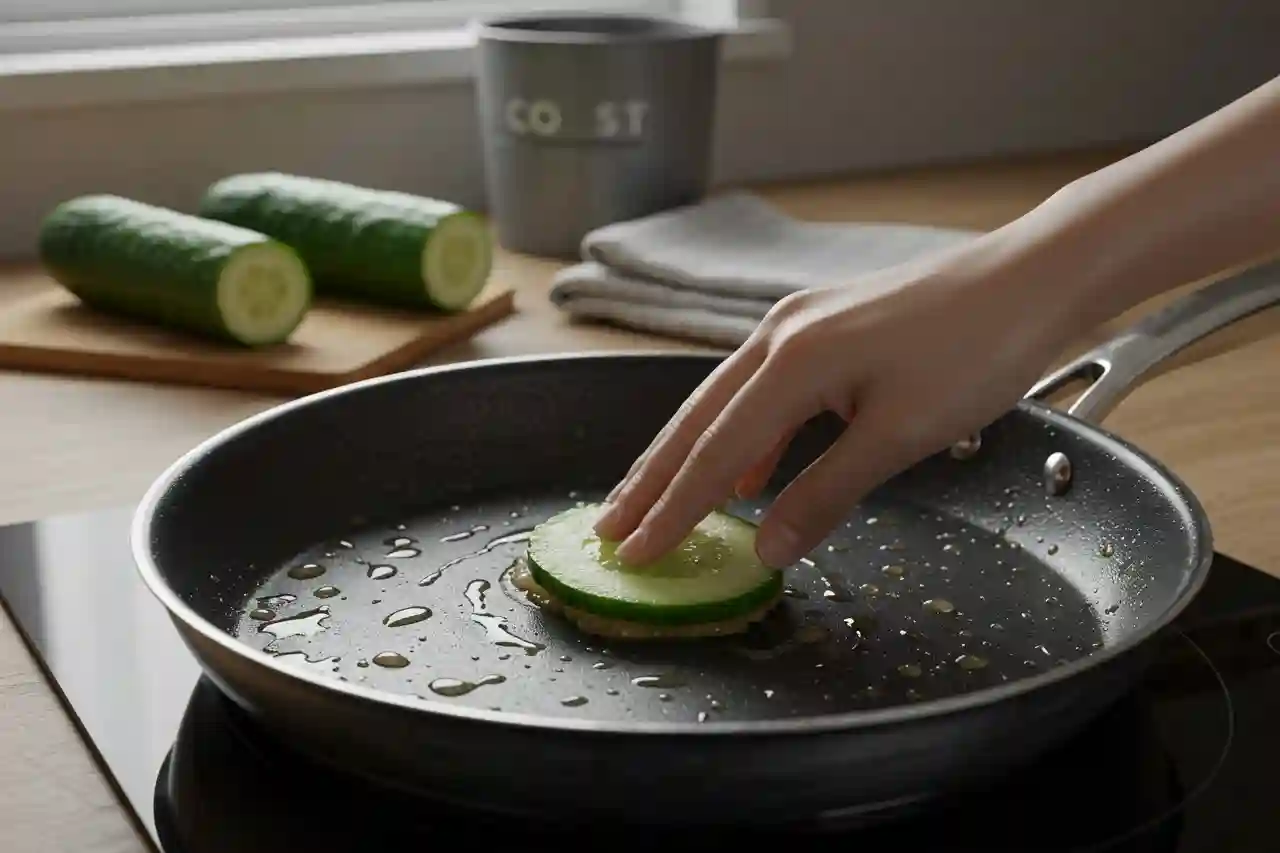I never imagined the cucumber pan grease hack would become a go-to in my kitchen. One night after dinner, I was faced with a greasy skillet and no soap in sight. Remembering this natural trick, I sliced a cucumber and gave it a try and it worked.
At Primed Recipes, we love simple, waste-free tricks that actually deliver. This cucumber pan grease hack is one of those rare finds: natural, effective, and gentle on cookware. In this guide, I’ll show you exactly how to use it and why it works.
What Is the Cucumber Pan Grease Hack?
This clever kitchen trick uses a fresh slice of cucumber to remove grease from your pan no soap or chemicals needed. Although it may sound unusual, there’s solid logic behind it. Here’s why so many home cooks are giving it a try:
- Simple Technique: Instead of scrubbing, you gently rub the juicy side of a cucumber slice across a warm (not hot) greasy surface. As you rub the cucumber across the surface, its natural juices help break down the oily film, making it easier to clean.
- Natural Cleaning: Because cucumbers contain mild acids and high water content, they help dissolve grease without damaging the pan’s surface.
- No Harsh Chemicals: Unlike store-bought cleaners, this method relies entirely on natural ingredients. Therefore, it’s safer for your skin and cookware.
- Eco-Friendly Approach: After using the cucumber, you can compost the slice meaning there’s no waste left behind. Additionally, you reduce your reliance on single-use paper towels or synthetic sprays.
- Quick and Accessible: Chances are, you already have a cucumber on hand. So when you’re out of dish soap or looking for a gentle option, this method is a convenient fix.
Ultimately, the cucumber hack is about simplicity, sustainability, and surprising results. Now that you know what it is, let’s move on to how you can try it yourself.
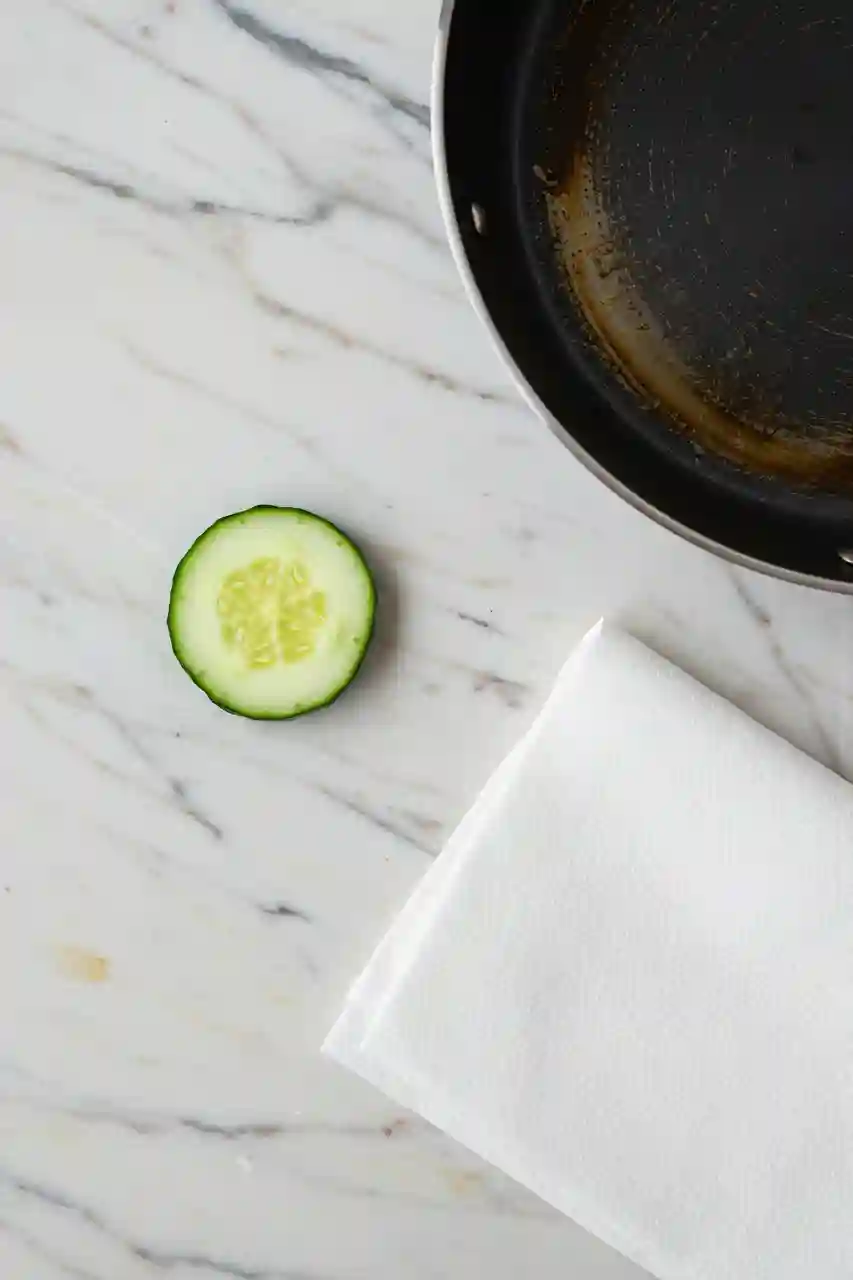
Step-by-Step: How to Use cucumber pan grease hack
This cucumber hack isn’t just a fun trend it genuinely works. Follow the steps below to naturally lift grease from your pan without using soap or scrubbing pads.
Time needed: 1 minute
How to Use it:
- Let the pan cool slightly
After cooking, set your greasy pan aside for a few minutes. It should feel warm to the touch, but not hot. This helps the cucumber work without steaming or cooking it on contact.
- Cut a thick slice of cucumber
Slice from the middle of the cucumber where the moisture content is highest. The wider surface area makes it easier to cover more of the pan in less time.
- Rub the cucumber across the greasy surface
Gently press and move the cucumber slice in circles over the oily spots. As the juice spreads, it begins to lift the grease.
- Wipe with a towel or cloth
Once the residue loosens, use a paper towel or dishcloth to wipe the pan clean. You’ll notice the oil coming off with very little effort.
- Repeat if needed
For stubborn or burnt-on grease, use a fresh slice and go over the area again. It’s safe, gentle, and surprisingly effective.
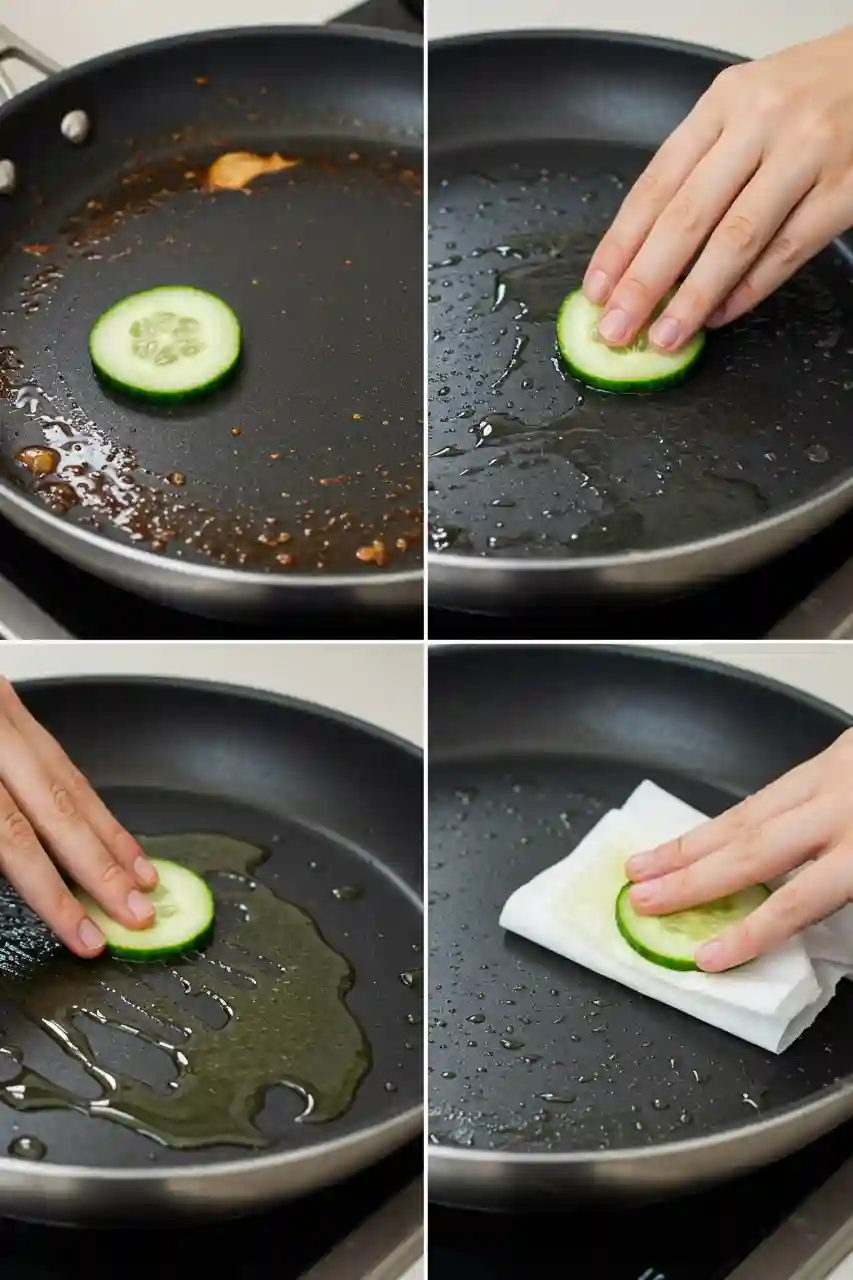
This method works best immediately after cooking while the pan is still warm. Next, let’s take a closer look at why this trick actually works from a food science perspective.
Why the Cucumber Pan Grease Hack Works So Well
It may seem odd that a vegetable can clean a greasy pan, but there’s science behind this kitchen hack. Here’s how it works and why cucumbers are more powerful than they look:
- High Water Content: Cucumbers are about 95% water. Because of this, they naturally release moisture as you rub them across a warm surface, helping to dissolve and lift grease particles.
- Mild Acidity: While cucumbers aren’t acidic like vinegar, they do contain small amounts of ascorbic acid and caffeic acid. These mild compounds can break down light oils, making the pan easier to wipe clean.
- Textured Surface: The skin and pulp of a cucumber offer a gentle abrasion. Unlike steel wool or scrubbing sponges, it won’t scratch your cookware, but it still adds a bit of friction to help dislodge stuck-on residue.
- Natural Enzymes: Some enzymes found in cucumber skin can interact with fats on a microscopic level. Although not as aggressive as detergents, they assist in loosening thin grease layers.
In combination, these qualities make cucumbers surprisingly effective for tackling pan grease. Moreover, this method leaves no synthetic residue behind, making it a safe option for families, sensitive skin, or non-toxic kitchens.
Next, let’s explore whether this trick is safe to use regularly and what experts have to say about using food for cleaning.
Is the Cucumber Pan Grease Hack Safe for Cookware?
Using food to clean cookware may raise a few eyebrows, but when it comes to safety, this cucumber grease hack holds up. Here’s what to know before making it a part of your kitchen routine:
- Food-Safe and Non-Toxic
Cucumbers are completely edible and chemical-free. Since you’re not introducing harsh substances, there’s no risk of chemical residue on your cookware. Therefore, it’s safe for families and ideal for eco-conscious kitchens. - Won’t Damage Cookware
Because cucumbers are soft and contain no abrasive grit, they won’t scratch nonstick coatings, stainless steel, or cast iron surfaces. As long as the pan isn’t overheated during cleaning, it remains unharmed. - No Skin Contact Reactions
Cucumbers are gentle on skin they’re even used in skincare. Unless you have a rare cucumber allergy, this method is perfectly safe for your hands. - Compostable Waste
After use, the cucumber slice can be composted. Not only does this reduce kitchen waste, but it also avoids throwing away extra paper towels or synthetic sponges. - Expert Opinions
While not every kitchen professional uses this method daily, some chefs and dietitians support it as a temporary, zero-waste cleaning tip. It’s especially useful for quick pan wipes before a deeper clean.
So, while it’s not a full replacement for soap, it’s a safe and surprisingly effective tool to add to your cleaning routine. Up next, let’s see how cucumber compares to other natural degreasing options.
Cucumber Pan Grease Hack vs Soap, Vinegar & Baking Soda
You may wonder how the cucumber hack stacks up against more familiar kitchen cleaners. While each method has distinct benefits, cucumber offers a gentle, eco-conscious alternative that many overlook.
How the Cucumber Grease Hack Compares for Cleaning Power
When evaluating cleaners, grease-cutting ability and surface safety matter most. Below is a clear comparison:
| Cleaner | Grease Removal | Surface Safety |
|---|---|---|
| Cucumber | Moderate for light grease | Safe on all cookware |
| Dish Soap | High — cuts heavy grease | Varies by brand |
| Baking Soda | Strong on burnt residue | Mildly abrasive |
| Vinegar | Effective on oily film | Safe, scent may linger |
Sustainability of the Cucumber Pan Cleaning Method
Choosing the right cleaning agent also comes down to environmental impact. Here’s how these options compare:
| Cleaner | Eco-Friendly? |
|---|---|
| Cucumber | Yes — compostable and chemical-free |
| Dish Soap | No — contains synthetic agents |
| Baking Soda | Yes — biodegradable and natural |
| Vinegar | Yes — naturally sourced and non-toxic |
Should You Use the Cucumber Pan Hack? Final Thoughts
While cucumber may not remove heavy, baked-on grease like commercial soap or baking soda, it excels in quick, light cleans. It’s gentle on cookware, leaves behind a clean scent, and creates no waste a rare combination in everyday kitchen cleaning.
Next, we’ll look at the broader zero-waste benefits of using this trick in your cooking routine.
Zero-Waste Benefits of the Cucumber Pan Grease Hack
Beyond cleaning, this trick fits beautifully into a zero-waste lifestyle. If you’re looking for ways to reduce kitchen waste and avoid harsh chemicals, this simple hack does more than just wipe away grease.
Cuts Down on Chemical Use
Most commercial cleaners leave behind chemical traces even after rinsing. In contrast, cucumbers are food-safe, meaning you can clean your pan and cook again without worrying about residues. Therefore, you reduce your dependence on synthetic cleaning agents.
Reduces Paper Towel Waste
Instead of using multiple paper towels or disposable wipes, the cucumber does the heavy lifting. You often need just one towel to finish the job. As a result, you’ll go through fewer rolls and create less trash.
Compostable Cleaning
When you’re done, toss the used cucumber slice in your compost bin. It breaks down naturally, unlike cleaning wipes or sponge pads that take months or years to degrade.
Less Packaging, More Purpose
Buying fewer cleaning products means less plastic packaging. If you already keep cucumbers in your fridge, this trick makes use of ingredients you already have no extra purchase required.
Supports Gentle Living
Finally, this hack aligns with a mindful kitchen mindset: using what’s fresh, reducing waste, and keeping things simple. It’s a small habit that adds up over time, especially when shared with others.
In short, it’s not just about degreasing your pan it’s about creating a cleaner, calmer kitchen with fewer disposable products and more sustainable habits.
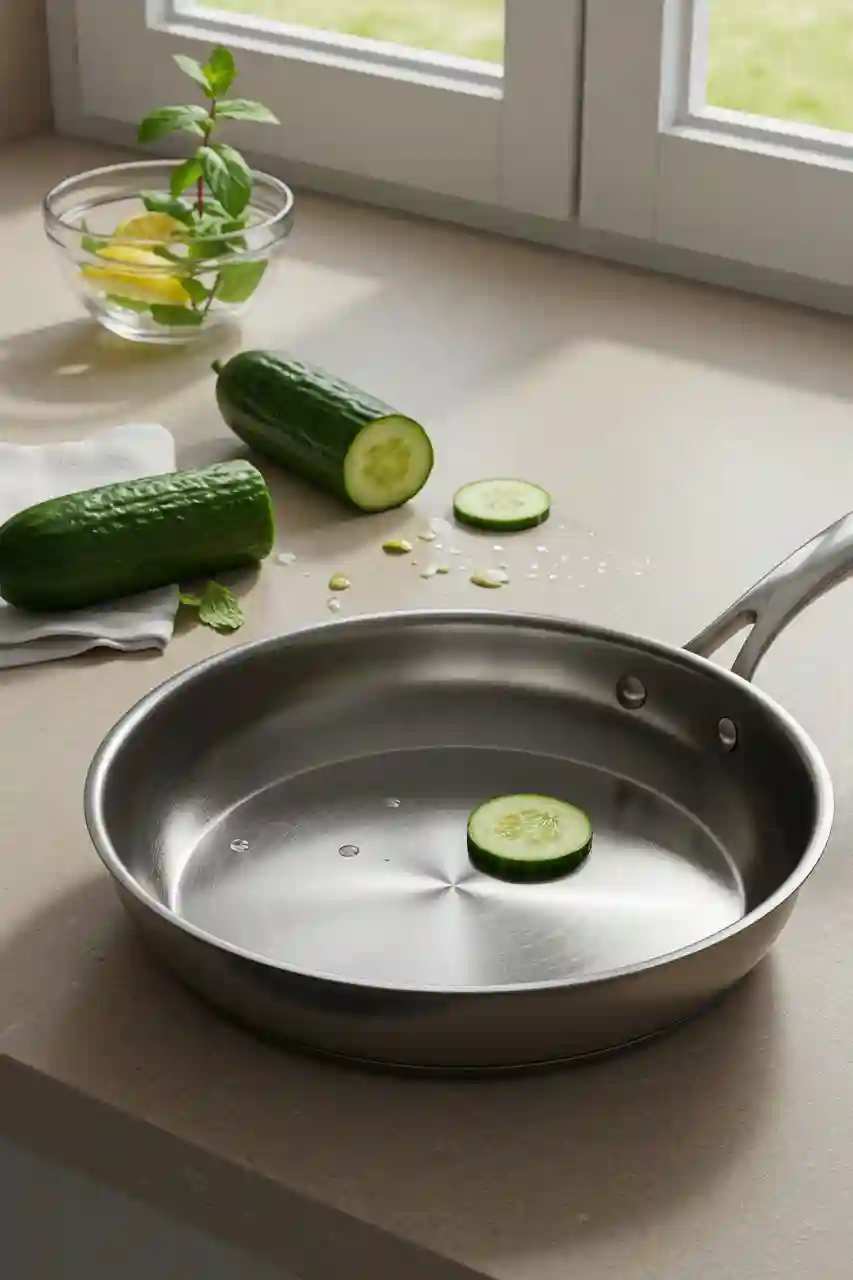
FAQs: All Your Questions Answered
Yes, you can. Rubbing a fresh cucumber slice on a warm pan helps lift grease naturally thanks to its high water content and gentle acidity. It’s safe, effective, and eco-friendly for light degreasing.
Not exactly. While cucumber can mimic the effect of a nonstick surface by loosening light residue, it doesn’t replace oil for cooking. It’s best used as a natural cleaning aid, not a cooking substitute.
Use a slice of cucumber on a warm pan to break down grease. Its moisture loosens the oil, which can then be wiped away with a cloth. This works well for light, surface-level residue.
It depends on the situation. For natural, chemical-free cleaning, cucumber is excellent for fresh grease. For tougher messes, baking soda, vinegar, or dish soap remain more effective.
Burnt-on grease requires stronger methods. Soak the pan with baking soda and hot water, then scrub gently. Cucumber is better for light residue, not baked-on or carbonized layers.
Use It in Your Zero-Waste Kitchen Routine
The cucumber pan grease hack isn’t just a cleaning trick — it’s part of a smarter, cleaner kitchen routine. Here’s how to take it further:
- Try our creamy cucumber salad to use up extra slices and reduce food waste.
- Explore healthy swaps with our guide on avocado toast as a healthy fat — ideal for grease-free cooking inspiration.
- Make your own condiments like this homemade mustard recipe to cut packaging and processed ingredients.
These small choices support a zero-waste kitchen clean pans, clean eating, and less waste every day.
Is the Cucumber Pan Grease Hack Safe?
Yes when used properly, it’s safe. Here’s what expert sources say:
- Wash before use: The USDA recommends rinsing cucumbers with cool water only — no soap — to remove contaminants safely.
- Contamination risk is minimal: According to UF/IFAS food safety experts, any risk stems from handling, not the cucumber itself.
- Cucumber is compositionally safe: A study by IGMIN Research confirmed cucumber’s metal content is far below harmful levels.
Always wash cucumbers before using them on cookware. This keeps your hack clean, safe, and effective without introducing any risk to your kitchen.
Print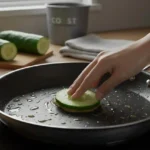
Cucumber Pan Grease Hack Recipe
- Total Time: 1 minute
- Yield: 1 pan cleaned
- Diet: Vegan
Description
Say goodbye to greasy pans with this quick, natural cucumber hack. Using nothing more than a fresh cucumber slice, you can lift stubborn oil and grime without soap, scrubbing, or chemicals. Ideal for zero-waste kitchens and eco-conscious cooks, this trick is surprisingly effective, gentle on cookware, and safe for food surfaces.
Ingredients
- 1 thick slice of fresh cucumber
- 1 greasy pan or skillet
Make sure it’s warm, not hot — just after cooking is ideal. - (Optional) Paper towel or cloth<br data-start=”802″ data-end=”805″ />For final wipe and polish.
Instructions
- Let the pan cool slightly after cooking. It should feel warm to the touch but not hot.
- Slice a thick round from the middle of a cucumber.
- Rub the juicy side of the cucumber slice over the greasy surface of the pan.
- As the cucumber releases moisture, it will begin to loosen grease and residue.
- Use a paper towel or cloth to wipe the pan clean.
- For stubborn spots, repeat the process using a fresh slice.
- Compost the used cucumber and enjoy a chemical-free clean!
Notes
- For best results, use this method immediately after cooking, while the pan is still warm.
- This hack works well on stainless steel, nonstick, and ceramic pans.
- Avoid trying this on extremely burnt or carbonized surfaces — it’s best for light grease.
- Leftover cucumber? Try it in a salad or a refreshing summer drink.
- Prep Time: 1 minute
- Cook Time: 0 minutes
- Category: Cleaning Hacks
- Method: Manual rub
- Cuisine: Eco-Friendly

